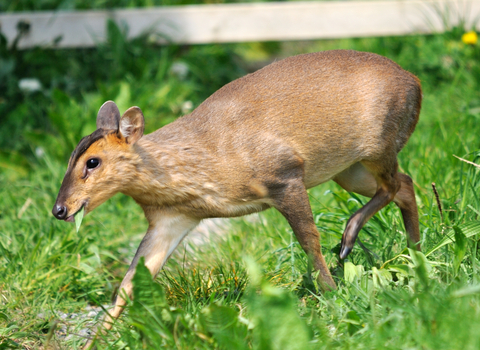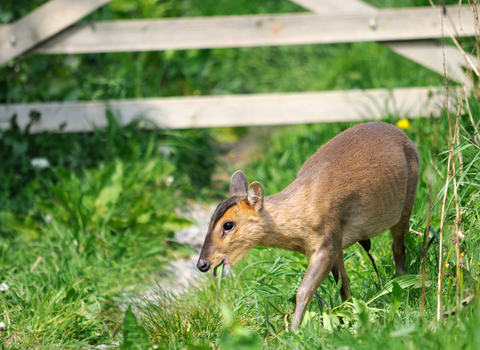
©Amy Lewis
Muntjac deer
Scientific name
Muntiacus reevesiWhen to see
January to DecemberSpecies information
Category
Statistics
Length: 77-91cmShoulder height: 45-52cm
Weight: 10-17kg
Average lifespan: 10-13 years
About
The small, Chinese muntjac deer was introduced to Woburn Park in Bedfordshire at the start of the 20th century and rapidly spread into the surrounding area. It is now a common animal across southeast England and can be found in woodland, parkland and even gardens. Muntjac deer are notorious browsers, eating the shoots from shrubs, as well as woodland herbs and brambles. This clearing of woodland understory has been linked to declines in species such as nightingales.Male muntjacs have short, unbranched antlers that slope backwards, and a pair of long canine teeth. They breed all year-round, but females usually only have one kid at a time. Muntjac deer are also known as 'barking deer' because of their dog-like calls.
How to identify
A very small, stocky deer, the muntjac deer is about the same size as a medium dog. It is gingery-brown, with a pale underside, darker stripes in its face, and small, single-pointed antlers.Distribution
Common and increasing in southern England, and spreading northwards.In our area
Muntjac deer have spread rapidly across Shropshire; their small stature allowing them to move around without being spotted too often. First recorded in the south of the county 20 years ago, they are recorded in woodlands in the Oswestry Hills, around The Stiperstones and as far north as Market Drayton. It is likely that the Muntjac in Shropshire have escaped from local estates, though it is possible that they have travelled here undetected from their strongholds in the southeast.
Did you know?
At least seven species of muntjac are known, from Pakistan to Java and China. Two species were actually introduced into the UK, but the one that got cosy here is the Reeves' muntjac.Muntjac deer have spread rapidly across Shropshire; their small stature allowing them to move around without being spotted too often. First recorded in the south of the county 20 years ago, they are recorded in woodlands in the Oswestry Hills, around The Stiperstones and as far north as Market Drayton. It is likely that the Muntjac in Shropshire have escaped from local estates, though it is possible that they have travelled here undetected from their strongholds in the southeast.

